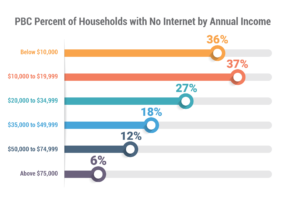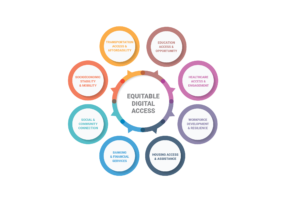27 Aug The Digital Divide: Detrimental consequences to those without access
What is the Digital Divide?
As the coronavirus pandemic rages on, it continues to expose and exacerbate many long-existing social inequities. Nationally, and in Palm Beach County specifically, neighborhoods that have been historically disinvested and exploited are the most vulnerable to the negative impacts of COVID-19. These neighborhoods remain largely segregated according to socioeconomic status and race.
The digital divide is the gap between those who have access to computers and the internet and those who do not. A lack of access during COVID-19 poses a significant threat to the health of the county’s already most vulnerable households. Data shows that residents of the most disconnected neighborhoods are expected to learn less, earn less, and live less than the average county residents.
As society restructures and adjusts, the livelihoods of many low-income families are jeopardized. These families may not have the resources necessary to participate in “the new normal.” In the current physically-distanced environment, access to healthcare, vital health information, education, virtual work, and applying for benefits are largely determined by the availability of technology in the home.
While the pandemic threatens the health and stability of all residents, access to technology, including high-speed internet and laptops or tablets, has become essential for everyone. In Palm Beach County, for example, 92,000 households, or 17% of all households, are not connected to high-speed internet (Census ACS 2014-2018).

A survey completed by Quantum in the Community (QIC) partners reported that, on average among respondents, greater than 33% of their clients do not have internet and computer access at home. Digging deeper, it was indicated that the digital divide presents multiple challenges—even those who are connected still have trouble navigating the technology and online systems effectively.
Regardless of those challenges, QIC partners agreed that technology is paramount to their clients as they attempt to continue their education, maintain employment, apply for benefits, and connect to necessary health and social services.
This existing digital divide, made worse by the sudden shift to virtual learning and remote working, has created an environment in which equity gaps are likely to widen for a significant portion of the population. The resulting negative outcomes will further increase the burden placed upon healthcare providers, local governments, and nonprofit organizations to address the downstream consequences of the existing inequity.
Residents of the most disconnected census tracts in Palm Beach County are expected to learn less, earn less, and live less than the average county resident. The table below shows outcome data for residents of the 15 census tracts in the county with the highest rates of households without high-speed internet access.
Reshaping Systems for More Equitable Health
Because access to the internet and computers is so critical to life during the current health crisis, technology presents a significant opportunity to reshape systems for more equitable health. As it stands, a person’s access to quality healthcare, education, employment, and financial services is largely defined by where they live. If equitable access can be achieved, technology can increase a person’s ability to overcome the negative social determinants of health (SDOH) they have experienced in their community and improve the trajectory of their life.
Immediate Digital Access
Decisive, collaborative action must be taken to provide immediate digital access to students and families in these neighborhoods. Moving forward, the county’s disinvested communities require a long-term commitment to equity among all sectors to address the conditions that are being amplified by COVID-19. Private, public, and nonprofit institutions must work in partnership with residents and community leaders to invest in the improvement of neighborhoods, expand educational and economic opportunities for families, and close the digital divide in the most disconnected communities.



